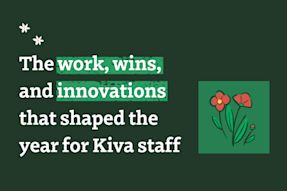A lack of access continues to exclude so many from traditional financial services and the stability they bring. A whopping 1.7 billion adults around the globe are unbanked, which means they can’t benefit from conventional credit and capital, or even save money efficiently.
At Kiva, we’re well-known for our role in supporting the individuals who are faced with these challenges. Since our founding, we have helped to deploy over USD 1.5 billion in loans to over 4 million borrowers. Through crowdfunded loans, we are able to provide the capital that people need to grow a business, fund their education, or launch a sustainable venture for their community.
As well as enabling financial access for individuals, Kiva is working to improve the underlying circumstances that cause the need for microloans in the first place.
We have a lot of conversations about “systemic change” around here:
-
How do we promote financial inclusion in fragile communities?
-
What innovations will have the greatest impact?
-
How can we invest in lasting change to create equal economic opportunity for all?
One of the innovative projects that has come out of these kinds of discussions is Kiva Capital. Launched in 2019, Kiva Capital is an impact-first asset manager built on the successful crowdfunded microlending approach of Kiva.org. Alongside lenders on Kiva.org who direct $25, $100, or a $5 Monthly Good loan to one borrower at a time, Kiva Capital offers a platform for entities that want to deploy large sums of money to create impact. By pooling together millions of dollars from institutional investors and deploying that capital across a diversified portfolio of partners, we are able to help fund the expansion of their services and programs to more communities.
After launching two international investment funds and administering a California-focused loan fund, Kiva Capital is poised to scale up its support toward accessible financial solutions across communities and entire regions.
One-to-one lending changes lives. We can change the system, too.
Support Kiva’s work with a donation
Kiva Capital helps further Kiva's mission
While the goal of Kiva Capital is aligned with the mission of Kiva.org, its objective is to expand the set of investors it connects with to reach underserved communities.
“As an asset manager, Kiva Capital channels larger-sized capital from investors to invest in our partners—also known as ‘portfolio companies’—some of which have partnered with us for years on Kiva’s crowdfunding platform,” explains Celia Wong, Managing Director of Kiva Capital.
 Celia Wong, Managing Director of Kiva Capital
Celia Wong, Managing Director of Kiva Capital“These partners tend to require more capital to scale up their successful programs, with the goal to expand their reach to support more communities and end clients, especially women and other underserved populations.”
What does it mean to be an impact-first investor?
“For us, ‘impact-first investing’ means we prioritize generating meaningful outcomes before maximizing a financial return.”
Kiva Capital’s objective is to generate positive, measurable social impact alongside investment returns.
“For us, ‘impact-first investing’ means we prioritize generating meaningful outcomes before maximizing a financial return,” says Celia, adding that this philosophy tends to bring together like-minded investors.
Kiva Capital supporters come from all kinds of backgrounds, from high-net-worth individuals and private foundations to mission-focused family offices and development finance institutions. Celia also notes that more companies have signed on as of late.
“In recent years, we’ve also seen more corporations making investments to create social impact that amplifies or aligns with their business strategies or corporate values.”
Where does the capital go?
Since its inception, Kiva Capital has aligned its impact with specific thematic strategies, including serving as administrator of The California Rebuilding Fund (CARF) to support under-resourced local businesses in response to COVID-19, and launching and managing the Small Business Resilience Fund (SBRF) to bolster access to capital by small businesses in emerging markets impacted by COVID-19.
In one example of Kiva Capital’s reach, microfinance partner ECLOF Kenya has been developing higher-education loans and climate-smart financing products for dairy farmers for over seven years through Kiva’s microlending program. A recent SBRF investment will allow ECLOF to strengthen its balance sheet, catalyze additional debt investors, and expand its reach to tens of thousands more customers.*
Kiva Capital’s most recent fund launch is the Kiva Refugee Investment Fund (KRIF) which increases access to financial services for refugees, internally displaced persons, impacted host populations, and populations at risk of being forcibly displaced. After closing with $32.5M USD in 2021, KRIF has been expanding access to financial services to its target populations via microfinance partners in the Middle East, Africa, and Latin America.
Another longtime Kiva partner, FATEN, an NGO that supports small entrepreneurs in Palestine, has also benefited from next-level investment from Kiva Capital funds with a $3M USD loan from KRIF that will help to expand its reach to Palestinian refugees.*
Systemic change for gender equality
“It takes time to see the impact of these kinds of investments. But they can make lasting changes over years, and even decades.”
One of the most important impacts of Kiva has been to improve financial inclusion for women, and Kiva Capital aims to further deepen this area of work. Along with developing strategies to close gender gaps across the globe, Kiva published a Gender Lens Investing Landscape report last year and recently hosted the virtual Gender Equity + Financial Inclusion Forum. This Forum supported by USAID engaged almost 200 individuals from around the world to discuss how to advance gender equity at the intersection of financial inclusion.
Celia along with other Kiva colleagues led the Forum, which included a wide range of stakeholders from the financial inclusion community committed to advancing gender-forward practices, products, and services.
“I especially want to recognize women leaders from financial service providers and social enterprises who are not satisfied with the status quo and are driving trailblazing work,” says Celia.
“Over my career, I have felt so grateful for the opportunity to meet and engage with these inspirational leaders, and even more so, the women clients they serve around the world."
Even with Kiva Capital’s scaled funding and further reach, she reminds, there is much work to be done to surmount the barriers to gender equity and financial inclusion worldwide.
“It takes time to see the impact of these kinds of investments. But they can make lasting changes over years, and even decades.”
In other words, systemic change is a long game. But we’re here for it. We hope you are, too.
When you donate to Kiva, you help us continue to run innovative projects like Kiva Capital that scale our impact and push for systemic change.
Donate to Kiva
* This is one example of the type of obligor in which the fund invests and is not a guarantee of performance. The fund has invested, and may in the future invest, in other obligors in different geographies and with different financial and impact performance indicators. Past performance does not guarantee future results.
PREVIOUS ARTICLE
Microfinance interest rates, explained →NEXT ARTICLE
Mother’s Day gifts that make a difference →














